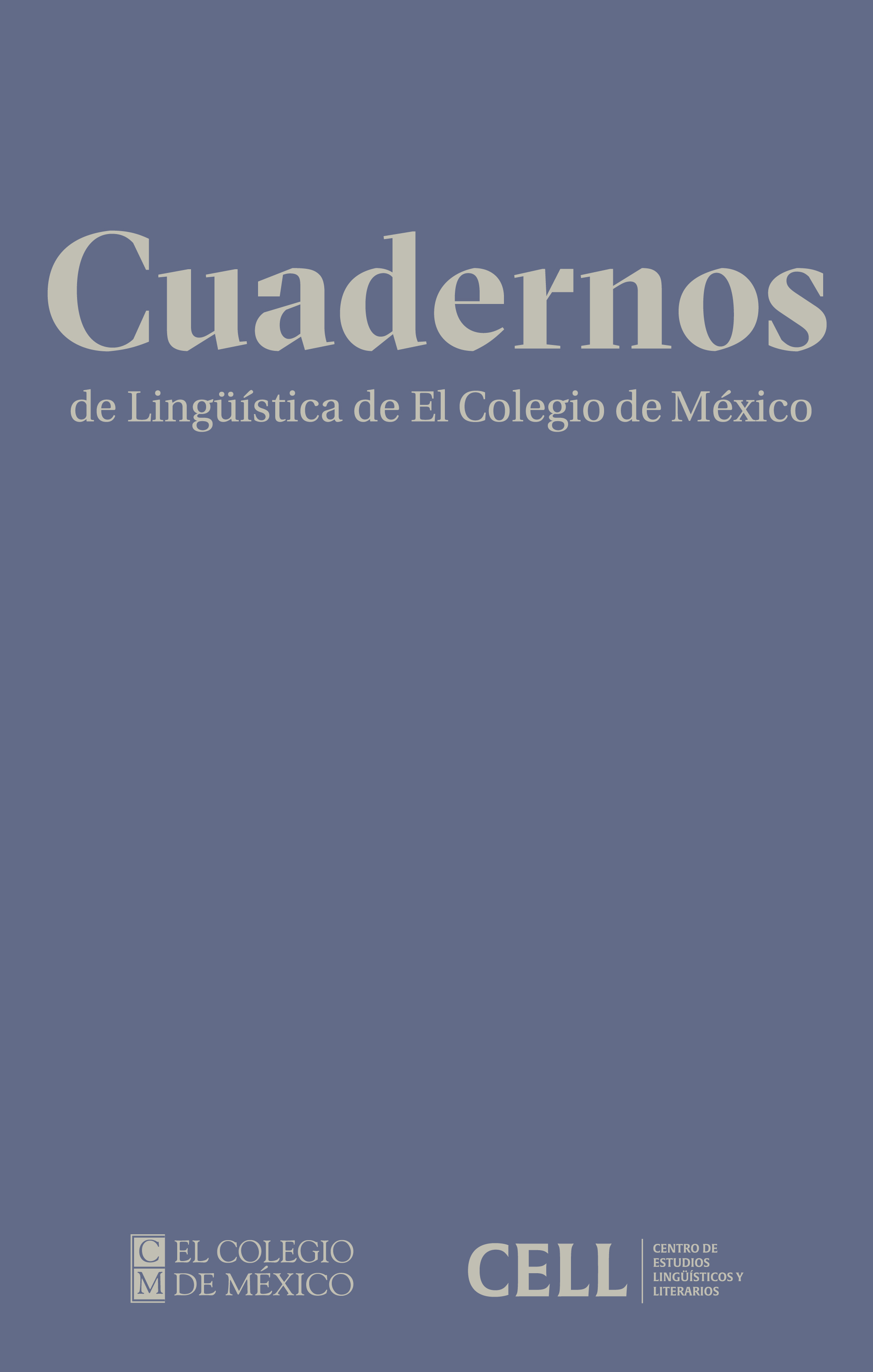Concluded event reading of ir + gerund periphrasis in Rioplatense Spanish
DOI:
https://doi.org/10.24201/clecm.v12.332Keywords:
gerund periphrasis, imperfective aspect, progressive aspect, scalar implicatureAbstract
In this paper, we analyze a peculiar use of the periphrasis ir + gerund, which we refer to as concluded event reading, attested in Rioplatense Spanish, which differs from the canonical ir + gerund in that it appears to express a situation where the event denoted by the predicate is presented as complete (e.g., De todo lo que ten.a para leer, Ana iba leyendo tres libros el miércoles ‘Out of everything she had to read, Ana was reading three books on Wednesday’ →leyó tres libros ‘She read three books’). Through a series of tests, we demonstrate that this construction constitutes a progressive structure (unlike the canonical form, which conveys a durative structure). Specifically, we argue that it describes a situation in which, at a specific point in time (the reference time), certain events have already taken place, while other potential events are expected to occur. Thus, the effect of perfectivity arises from the temporal anchoring of the progressive structure: the events denoted by the predicate are anterior to the reference time. The prospective interpretation, in turn, is pragmatically derived from a scalar implicature.
Downloads
References
Bertinetto, Pier Marco. 1986. Tempo, aspetto e azione nel verbo italiano: il sistema dell’indicativo. Firenze: Accademia della Crusca.
Bertinetto, Pier Marco; Ebert, Karen & De Groot, Casper. 2000. The progressive in Europe. En Dahl, Ö. (ed.), Tense and aspect in the languages of Europe, 517-558. Berlín: Mouton de Gruyter. DOI: https://doi.org/10.1515/9783110197099
DOI: https://doi.org/10.1515/9783110197099.4.517Bertinetto, Pier Marco. 2000. The progressive in Romance, as compared with English. En Ö. Dahl, Ö. (ed.), Tense and aspect in the languages of Europe, 559-604. Berlín: Mouton de Gruyter. DOI: https://doi.org/10.1515/9783110197099
DOI: https://doi.org/10.1515/9783110197099.4.559Bohnemeyer, Jürgen. 2014. Aspect vs. relative tense: the case reopened. Natural Language & Linguistic Theory 32(3). 917-954. DOI: https://doi.org/10.1007/s11049-013-9210-z
DOI: https://doi.org/10.1007/s11049-013-9210-zBonomi, Andrea. 1997. Aspect, quantification and when-clauses in Italian. Linguistics and Philosophy 20. 469-514. DOI: https://doi.org/10.1023/A:1005388230492
DOI: https://doi.org/10.1023/A:1005388230492Camus Bergareche, Bruno. (2004). Perífrasis verbales y expresión del aspecto en español. En Fernández, L. & Camus Bergareche, B. (eds.), El pretérito imperfecto, 511-572. Madrid: Gredos.
Carston, Robyn. 1995. Quantity maxims and generalised implicature. Lingua 96(4). 213-244. DOI: https://doi.org/10.1016/0024-3841(95)00016-S
DOI: https://doi.org/10.1016/0024-3841(95)00016-SComrie, Bernard. 1976. Aspect: an introduction to the study of verbal aspect and related problems (Vol. 2). Nueva York: Cambridge University Press. DOI: https://doi.org/10.2307/412958
Dowty, David. 1979. Word meaning and montague grammar. Dordrecht: Reidel. DOI: https://doi.org/10.1007/978-94-009-9473-7
DOI: https://doi.org/10.1007/978-94-009-9473-7Fernández de Castro, Félix. 1999. Las perífrasis verbales en el español actual. Madrid: Gredos.
Ferrero, Victoria. 2024. Significado prospectivo en el español rioplatense: el caso de va + gerundio. (Manuscrito)
García Fernández, Luis. 2006. Perífrasis verbales en español. En García Fernández, L. & Camus Bergareche, C. (eds.), Diccionario de perífrasis verbales, 9-58. Madrid: Gredos.
García Fernández, Luis. 2009. Semántica y sintaxis de la perífrasis <estar + gerundio>. Moenia: Revista Lucense de Lingúística & Literatura 15. 245-274.
Grice, Herbert Paul. 1975. Logic and conversation. En Cole, P. & Morgan, J. (eds.), Syntax and semantics 3: speech acts, 41-58. Nueva York: Academic Press.
DOI: https://doi.org/10.1163/9789004368811_003Horn, Laurence. 1984. A new taxonomy for pragmatic inference: Q-based and R-based implicature. En Schiffrin, D. (ed.), Meaning, form and use in context, 11-42. Washington, DC: Georgetown University Press.
Ippolito, Michela. 2003. Presuppositions and implicatures in counterfactuals. Natural language semantics 11(2). 145-186. DOI: https://doi.org/10.1023/A:1024411924818
DOI: https://doi.org/10.1023/A:1024411924818Klein, Wolfgang. 1992. The present perfect puzzle. Language 68(3). 525-552.
DOI: https://doi.org/10.2307/415793Kornfeld, Laura; Trebisacce, Romina & Sciutto, Eugenia. 2023. Terminó siendo una perífrasis difícil: un análisis aspectual de terminar + gerundio. Revista Verba. Anuario galego de filoloxia 50. 1-27. DOI: https://doi.org/10.15304/verba.50.7874
DOI: https://doi.org/10.15304/verba.50.7874Laca, Brenda. 2004a. Progressives, pluractionals, and the domains of aspect. Domaines, Journées d’Études linguistiques. 87-92.
Laca, Brenda. 2004b. Romance “aspectual” periphrases: eventuality modification versus ‘syntactic” aspect. En Lecarme, J. & Guéron, J. (eds.), The Syntax of time, 425-440. Massachusetts: MIT Press.
DOI: https://doi.org/10.7551/mitpress/6598.003.0018Laca, Brenda. 2006. Pluralidad y aspecto verbal en español. Revista Española de Lingüística 36(1). 7-41.
Levinson, Stephen. 1987. Minimization and conversational inference. En J. Verchueren, J. & Bertuccelli-Papi, M. (eds.), The pragmatic perspective, 61-129. Ámsterdam: Benjamins.
DOI: https://doi.org/10.1075/pbcs.5.10levMair, Christian. 2012. Progressive and continuous aspect. En Binnick, R. (ed.), The Oxford handbook of tense and aspect, 803-827. Oxford: Oxford University Press. DOI: https://doi.org/10.1093/oxfordhb/9780195381979.001.0001
Markič, Jasmina. 1990. Sobre las perífrasis verbales en español. Linguistica 30(1). 169-206. DOI: https://doi.org/10.4312/linguistica.30.1.169-206
DOI: https://doi.org/10.4312/linguistica.30.1.169-206Morimoto, Yuko. 2000. Los verbos de movimiento. Madrid: Visor.
Patard, Adeline. 2014. When tense and aspect convey modality. Reflections on the modal uses of past tenses in Romance and Germanic languages. Journal of pragmatics 71. 69-97. DOI: https://doi.org/10.1016/j.pragma.2014.06.009
DOI: https://doi.org/10.1016/j.pragma.2014.06.009(NGLE) RAE-ASALE. Real Academia Española-Asociación de Academias de la Lengua Española. 2009. Nueva gramática de la lengua española (Vol. 2). Madrid: Espasa Calpe.
Rothstein, Susan. 2004. Structuring events. Oxford: Blackwell Publishing. DOI: https://doi.org/10.1002/9780470759127
DOI: https://doi.org/10.1002/9780470759127Rothstein, Susan. 2008. Two puzzles for a theory of lexical aspect: semelfactives and degree achievements. Event structures in linguistic form and interpretation 8. 175-198. DOI: https://doi.org/10.1515/9783110925449.175
DOI: https://doi.org/10.1515/9783110925449.175Smith, Carlota. 1991. The parameter of aspect. Dordrecht: Kluwer.
Squartini, Mario. 1998. Verbal periphrases in Romance. Nueva York: Walter de Gruyter. DOI: https://doi.org/10.1515/9783110805291.
DOI: https://doi.org/10.1515/9783110805291De Swart, Henrietta. 2000. Tense, aspect and coercion in a cross-linguistic perspective. En Proceedings of the Berkeley formal grammar conference (Vol. 20). Berkeley: Universidad de California.
Trebisacce, Romina & Ferrero, Victoria. 2021. El significado durativo e iterado de las construcciones con la perífrasis de progresivo perfectivo. En Bértola, C.; Oggiani, C. & Polakof, A.C. (ed.). Estudios de lengua y gramática, 131-145. Montevideo: Facultad de Humanidades y Ciencias de la Educación.
van Geenhoven, Veerle. 2004. For-adverbials, frequentative aspect, and pluractionality. Natural Language Semantics 12. 135-194. DOI: https://doi.org/10.1023/B:NALS.0000031389.36427.af
DOI: https://doi.org/10.1023/B:NALS.0000031389.36427.afvan Geenhoven, Veerle. 2005. Atelicity, pluractionality, and adverbial quantification. En Verkuyl, H.; van Hout, A. & de Swart, H. (eds.), Perspectives on aspect, 107-124. Dordrecht: Springer.
DOI: https://doi.org/10.1007/1-4020-3232-3_6Vendler, Zeno. 1957. Verbs and times. The Philosophical Review 66(2). 143-160.
DOI: https://doi.org/10.2307/2182371Yllera, Alicia. 1999. Las perífrasis verbales de gerundio y participio. En Bosque, I & Demonte, V. (eds.), Gramática descriptiva de la lengua española, 3391-3442. Madrid: Real Academia Española –Espasa Calpe.
Published
How to Cite
-
Abstract568
-
PDF (Español)173
-
XML (Español)7
-
EPUB (Español)61
-
Kindle (Español)511
-
MP3 (Español)7
Issue
Section
License
Copyright (c) 2025 Romina Verónica Trebisacce, Victoria Ferrero Cabrera

This work is licensed under a Creative Commons Attribution-NonCommercial 4.0 International License.
Authors retain copyright of their work and are free to disseminate it, make copies for any use, and/or deposit in any repository or archive of their choice, but they grant Cuadernos de Lingüística de El Colegio de México the right to publish the work for the first time. Authors agree to acknowledge Cuadernos de Lingüística de El Colegio de México as the site of original publication of their article / note / review through proper citation.
Articles appearing in Cuadernos de Lingüística de El Colegio de México are made available to readers under a Attribution-NonCommercial-NoDerivatives 4.0 International.









